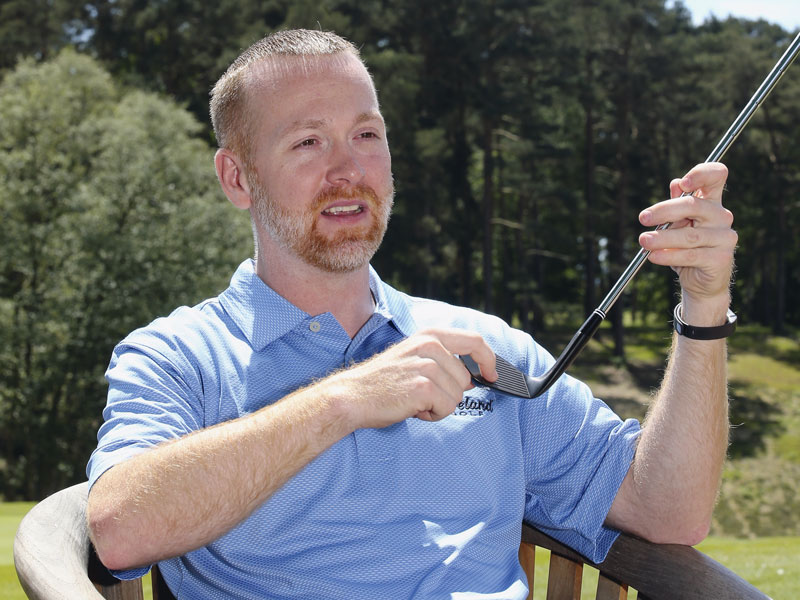John Rae: The spin doctor
Meet John Rae, the man behind a number of Cleveland’s best wedge-design innovations


Meet John Rae, the man behind a number of Cleveland’s best wedge-design innovations, including Zip Grooves and Rotex face technology
Ahead of the launch of sister brand Srixon’s new Z 155 and 355 series, we were given exclusive access to the man who oversees Cleveland Golf’s product designs. John Rae began working for the company in 1999, and now manages over 160 employees as Vice President of R&D. He was at the helm when Cleveland brought out the first-ever 460cc driver, and when it revolutionised wedge technology in the form of Zip Grooves. We caught up with him at Camberley Heath Golf Club in Surrey to discuss all things wedges...
What are the areas of wedge design you look to improve? Wedges are based around looks, feel and spin. It’s where our research starts. Looks-wise, it’s hard to innovate on shape. Historically, a wedge shape hasn’t changed much so it’s got to fit the eye of the golfer, but we also look at things like different PVD colours, different sole-finishing features and then what we can do on the back. When it comes to feel, it’s material selection – casting versus forging, then what materials to use and how to design the hosel transition, which can also dictate the feel. All the vibration starts in the head and moves its way up the hosel, but the main mode of vibration would be those two pieces moving against each other. The less vibration you get, the better it feels. A thick transition will make it feel amazing, but won’t look so good. So it’s a balance.
Spin, presumably, is king? Absolutely. Any design changes we make start with our tour players. They prioritise short-game spin. Almost all of them have too much spin on a full shot, but it’s around the green and out of the rough they want more spin. The RTX 2.0 technology has three parts – the grooves, the laser milling and the micro-milling on the face. The best way to think about it is on an old radio: the grooves are the big dial when it comes to spin, everything else is smaller dials. If you had a microscopic view of the face, you’d see big cavities which are the grooves and smaller cavities which are from micro-milling. When you zoom in, there are spikes and then each spike has another spike from the laser. Each piece combines to create maximum spin.
Related: Wedge Control
How much testing of different groove configurations do you do? A lot! It’s really hard to test a wedge because so many little things play a big part. One example is if we put a wedge in our robot and hit it with a brand new golf ball, then put the same ball back in and hit it again on the same impact point, there’s a significant loss in spin. Also little bits of debris we can’t even see play a part in spin, so it’s hard to do a test where you’re hitting shots with wedges and determining the finer details. So we flipped the process and developed a spin cannon where instead of swinging a club, we fire a golf ball. The golf ball shoots out with no spin and then we can put an entire wedge or face plate in its path, bounce the ball off it and measure the spin. We can also rotate it through any angle to replicate different angles of attack and lofts and can change the ball speed to simulate different swing speeds. Wet newspaper works well as a replica for grass. Getting more data allows us to notice the finite differences in performance. We work through hundreds of different face designs, spacing the grooves out differently, putting them at different angles, testing in different conditions. We also change the materials to assess durability, seeing if the grooves degrade over time.
Do you agree with the groove rule? Probably not, because it hasn’t accomplished what they wanted it to. The goal was to target all those players who weren’t bothered about hitting fairways with their drivers because they knew they could spin it. But that strategy hasn’t changed – tour players are still trying to hit the ball as far as they can because they know that hitting a full 5-iron from the fairway is harder than hitting an 8-iron out of the rough. There used to be a maximum width, depth, number of grooves and sharpness. Now, there’s a holistic total and you can get to it in different ways and manufacturers are going in different directions. There’s more variety in the technology and I think that’s a good thing.
Get the Golf Monthly Newsletter
Subscribe to the Golf Monthly newsletter to stay up to date with all the latest tour news, equipment news, reviews, head-to-heads and buyer’s guides from our team of experienced experts.
Why are Cleveland wedges not forged? Firstly, 60 to 70 per cent of wedges sold across the board aren’t forged. Mainly, we find that there’s a bigger difference in feel between forged and cast wedges when they’re raw, which is more commonly found at the professional level. But as a product for retail, we need to put a chrome layer on it to stop it rusting. The chrome finish comes in two parts: a thick nickel layer and a chrome layer on top. When we put those on, even our tour pros can’t tell the difference between a cast and forged wedge. I had this argument with Jim Furyk a few years ago when he complained we didn’t have forged wedges. So I gave him a forged wedge and a cast wedge and asked him to go and hit some shots. Sure enough, he thought the cast wedge was the forged wedge. He had been convinced forged wedges felt better when in reality the difference is minute –and we can’t justify the extra cost. Instead, we invest in getting tighter tolerances, developing new groove technology, adding micro-milling, etcetera, as this contributes more to performance.
What frustrates you about wedge design? I get frustrated by companies that come out with different wedge grooves in different lofts. I think you should be able to use every wedge in your bag on any shot. For example, your 60° wedge isn’t only your bunker club and your 56° isn’t only the club you chip with from the rough. It doesn’t make sense to put ‘good’ grooves in one loft and ‘bad’ grooves in another. It also frustrates me that the whole process takes so long. We’re always working on new technologies and it feels like we should be turning things around quicker, but working with vendors across the world is time-consuming.
How does enhanced groove technology affect a ball’s durability? It’s the sharp edges of a groove that causes any scuffing, not the milling on the face. The USGA rule has helped in that it has forced us to take the sharpness out of the edge of the grooves. Before that we were good at making sharp-edged grooves, so much so they were changing how grooves functioned. Their main purpose is to get the bad material, like grass and dirt, out of the way so there’s more contact between the ball and the face. As grooves were getting sharper they were turning into claws, digging into balls, tearing them apart and generating loads of spin.
How important is the material of a wedge? Spin comes from the geometry or face design rather than the material. The harder the material is the more durable it tends to be, but that tends to work against feeling good. We work on things like a localised treatment to harden the face without affecting the feel.
How do you assess feel? It’s both subjective and scientific. The scientific approach is where we have a bunch of sensors on the club that measure every vibration that comes up the shaft and then back track that to frequencies. The head vibrates first, then the flange (the weakest point of the club), then by measuring it we can figure out how large the amplitude of the vibration is. So that gives us our static number, then we do player testing for consumer feedback for our subjective testing. In the end we’re trying to match the two.
What innovation are you most proud of with the new Z155/355 Srixon series? I am most proud of the Action Mass technology and the courage it takes to release that type of technology. For years, golf equipment manufacturers have followed a ‘pyramid of influence’ approach whereby we get product played at the top of the pyramid (PGA Tour) and then let that acceptance trickle down. The problem with this is that lower-level players are different from elite players and as such need different things. Action Mass technology is a perfect example of that. It is not ideal for tour players and it is not ideal for older golfers. It is ideal for golfers in their 20s to 40s who need consistency. I think it takes a lot of courage and faith in your research to launch a main product based on a technology that you know tour players won’t use.
Have you been tempted to use Srixon’s shaft technology in Cleveland wedges? We could use Miyazaki for our own graphite wedge shaft but we tend to find the market for graphite wedge shafts is pretty low. People aren’t keen to hand over extra money for the graphite technology in wedges.
What is Cleveland’s future strategy? Long term, Cleveland will become a 125-yards-and-in brand. We had the best-selling wedge in the UK last year, and soon we’ll have a more premium putter line-up that started with the TFI model earlier this year.
David joined Golf Monthly in 2015 as a content editor for the magazine and regularly contributes to the website. He has worked in magazine publishing and editing since 2003. He is a keen golfer and up until recently was a member of Blackmoor Golf Club in Hampshire. He has covered various big events and tournaments for GM, the highlight of which was witnessing Tiger Woods win his 15th Major at Augusta in 2019. Email: david.taylor@futurenet.com
-
 Volvo China Open 2025 Picks, Odds And Predictions
Volvo China Open 2025 Picks, Odds And PredictionsFollowing a break for The Masters, the DP World Tour returns for the final two weeks of its Asian Swing and the Volvo China Open is the penultimate event
By Jonny Leighfield
-
 Rory McIlroy's Sports Psychologist Explains Why He 'Didn't Talk' To Bryson DeChambeau In Masters Final Round
Rory McIlroy's Sports Psychologist Explains Why He 'Didn't Talk' To Bryson DeChambeau In Masters Final RoundDeChambeau raised eyebrows at Augusta National when claiming that McIlroy wouldn't engage in conversation during the final round of The Masters
By Jonny Leighfield